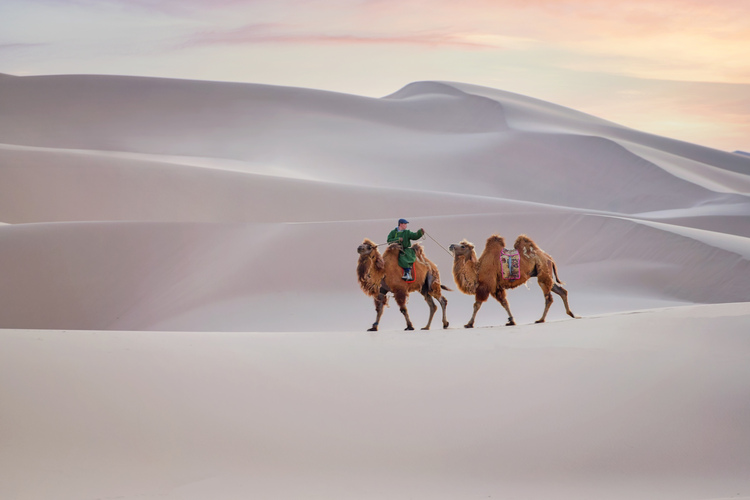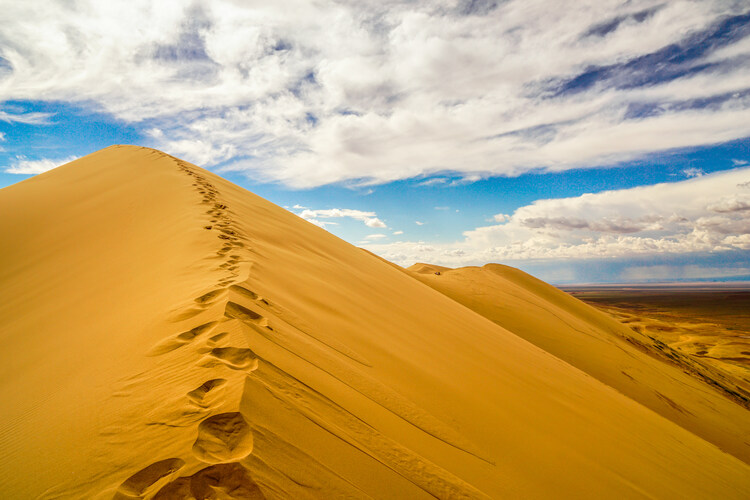
The Gobi is the largest desert in Asia and the fifth largest in the world – rich in minerals and home to ruined temples and once vital Silk Road routes
By
The Gobi, also known as the Gobi Desert, lies across southern Mongolia and northwestern China – a vast desert expanse around 1,600km (1,000 miles) long, 500-1,000km (300 to 600 miles) wide. With an area of around 1.3 million square km (500,000 square miles), it is larger than Germany and France combined.
The desert is composed of five distinct eco-regions: the Gaxun Gobi, Junggar Gobi, and Trans-Altai Gobi in the west; the Eastern or Mongolian Gobi in the centre and east; and the Alxa Plateau or Ala Shan Desert in the south.
The Gobi’s precise location is between the Altai Mountains and Hangayan Mountains to the north; the Yin, Qilian, eastern Altun and Bei Mountains to the south; the western edge of the Da Hinggan range to the east and the eastern Tien Shan to the west.
Related articles
Climate
Its name is derived from the Mongolian word ‘gobi’ – meaning ‘waterless place’ – and the desert certainly lives up to its name, with some areas not receiving any measurable rainfall for several years. Other regions within the Gobi can experience rainfall from less than 40mm, in the rain shadow of the Himalayas, to over 200mm in the Gobi-Altai mountains.
Sandy desert only accounts for around five per cent of the Gobi, with the majority of the desert being bare rock. Despite this, the Gobi is home to the Khongor Sand Dunes – 80 metres high, and 180km long – it is one of the world’s biggest sand dunes.

The Gobi has a continental climate with long, extremely cold winters. Temperatures can plummet to below -20C in January, rising to highs of over 33C in July.
Plants and wildlife in the Gobi
Small bushlike vegetation can be found on the plateau and plains beneath mountains in the Gobi, including yellowwood bean caper, winter fat and nitre bush – although vegetation is sparse in the desert. Vegetation becomes much richer in the semidesert tracts, with species including the Gobi feather grass, snakeweed and cold wormwood appearing.
In high mountains such as the Gobi Altai, desert-grass steppes cover lower slopes, and on the upper parts, mountain versions of the feather-grass steppes occur. However, vegetation cover has decreased since the 1950s, due to population increase and the overuse of marginal lands, causing the desert area of the Gobi to expand.
Currently, the Gobi is home to more than thirty mammals, herptiles and birds which are nationally threatened or endangered, including the Gobi brown bear and Asiastic wild ass or khulan. Large mammals, including camels, dzheiran gazelles and dzeren (an antelope), also live in the Gobi, as well as smaller rodents such as marmots and gophers, and reptiles. Due to the low mountain ranges of the Gobi, one of the most stable and productive populations of snow leopards can be found there.
Rapidly developing mining and related infrastructure pose an urgent threat to wildlife in the Gobi. In 2012 alone, 14 per cent of Mongolia’s surface area, and 24 per cent of the Gobi study area was leased for mineral exploration or extraction.
History of human habitation
The Mogao Caves complex of Buddhist temples near Dunhuang in the Gansu province of Chin was home to thousands of monks between the 4th and 10th centuries. The 492 cave temples are perfectly preserved, housing more than 2,000 painted sculptures and 45,000 square metres of murals, and the site was designated a UNESCO World Heritage Site in 1987.

In the 13th and 14th centuries, the Gobi was part of the Great Mongol Empire, and the southern part of the Alxa Plateau formed one of the significant routes along the Silk Road – a network of routes used by traders for over 500 years, beginning in 130 BCE when trade was opened by the Han dynasty of China, and ceasing in 1453 CE when the Ottoman Empire closed trade with the West.
Today, the majority of people who live in and around the Gobi are from the Mongol ethnic group, but there are also large constituencies of Han Chinese inhabitants. Most people in the desert now lead a nomadic life, often moving around and living in Mongolian Gers (yurts) as they raise cattle, such as Bactrian camels, cashmere goats, sheep and a small number of horses.
Those who have pastoral livelihoods in the Gobi today face threats following the move to a market economy in 1990. In response to this transition, livestock has nearly tripled – growing from 25 million to over 66 million – causing overgrazing. Concerns have been raised over ecological tipping points, the loss of knowledge of traditional practices and the loss of cultural identity.
New dinosaur discovered in Gobi Desert
In 2022, a new species of armoured dinosaur was identified in the southern Gobi Desert – with scientists believing it may have used its tail as a weapon. Bones, including a well-preserved skull, vertebrae a tail club and pelvic bones, were discovered back in 2008 during the Korea-Mongolia International Dinosaur Expedition.
The new species was identified and named as Tarchia tumanovae by researchers from the Southern Methodist University in Dallas, Texas, as well as universities in South Korea, Mongolia and Japan.
The newly-identified dinosaur had unique characteristics in its beak, armour and tail, and will aid scientists in understanding the evolutionary patterns of dinosaurs.
Bacterium in Gobi Desert harvests solar energy
A new bacterium was discovered in 2014 at Lake Tien E Hu, which is able to conduct an ancient form of photosynthesis.
The bacterium contained bacteriochlorophyll, a pigment related to chlorophylls which are normally found in plants to help carry out photosynthesis, according to the study by the University of Sheffield.
‘This structural and functional study has exciting implications because it shows that G. phototrophica has independently evolved its own compact, robust, and highly effective architecture for harvesting and trapping solar energy,’ said Dr Pu Qian of the University of Sheffield.
Traces of ancient Turks in Gobi
In 2022, a scientific team led by Semih Güneri identified archaeological documents which show the cultural connections between an ancient Turkish group and a region in the Gobi.
Researchers found three new Paleolithic settlements in the Gobi, discovering mammoth figures belonging to Altai Turks at different periods, alongside traces of the Upper Paleolithic Age. The Altai Turks were ancient Turkic ethnic groups that lived mainly in Siberia, located today in Russia.
‘The rock paintings of these large mammals, which became extinct in the last Upper Paleolithic Age, are the most interesting depictions of the time,’ Güneri added.
Petroglyphs, paintings and reliefs found on rocks, are useful in understanding the daily lives of local communities and their life events.
‘This line of rock paintings, which also passed through the Gobi Desert, is the most important evidence of Altai Turks’ presence in this region,’ Güneri explained.




